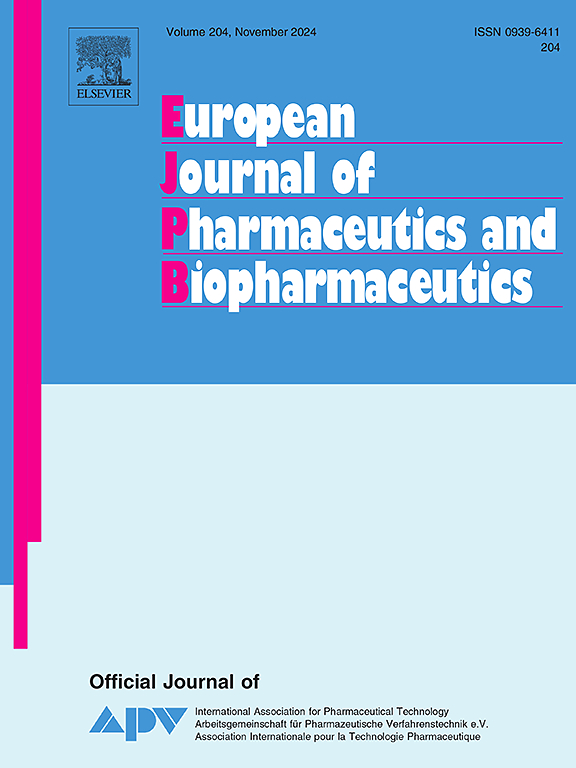喷雾冷冻干燥是制备鼠李糖乳杆菌GG益生菌粉的一种新型干燥工艺
IF 4.3
2区 医学
Q1 PHARMACOLOGY & PHARMACY
European Journal of Pharmaceutics and Biopharmaceutics
Pub Date : 2025-05-18
DOI:10.1016/j.ejpb.2025.114748
引用次数: 0
摘要
喷雾冷冻干燥是一种用于益生菌粉配方和稳定的干燥工艺,该技术将喷雾冷冻成冷蒸汽,然后进行旋转散装冷冻干燥,并研究了喷雾干燥和冷冻干燥的优点。该系统与使用该技术的其他研究的不同之处在于,饲料悬浮液被喷洒到冷却的大气中,而不是直接喷洒到液氮中。为了确保液滴的形成,使用了一种更滴落而不是喷射的技术,称为层流射流分解,而其他喷雾冷冻干燥技术使用二元喷嘴,单流体压力喷嘴,超声波喷嘴或旋转喷嘴。此外,旋转冷冻干燥的原理被用于散装冻干,其结果是冻干微粒而不是冻干饼。本研究考察了喷雾头相关参数及其对细菌活力和粉末粒度的影响。其次,对冷冻基质进行旋转冷冻干燥进行动态冻干的可行性进行了研究。此外,还对粉末密度、流动性和吸湿性进行了监测,以评估其在工业制造中的下游加工性能。据报道,细胞减量至少为1,0 log CFU/g,干燥产品中最大剩余细胞浓度为7,4 log CFU/g。在300µm喷嘴孔中,微球粒径为532±35µm,在400µm喷嘴孔中,微球粒径为739±57µm,平均球度为0.97。吸湿性调查报告了一个临界点,在40%的相对湿度,微球崩溃发生。总收率平均为92.1±4.2 %。本文章由计算机程序翻译,如有差异,请以英文原文为准。

Spray freeze drying as a novel drying process for the formulation of probiotic powders containing Lacticaseibacillus rhamnosus GG
Spray freeze drying was evaluated as a drying process for the formulation and stabilization of probiotic powders This technology combines spray freezing into cold vapour followed by rotational bulk freeze drying, and was investigated to combine the benefits of both spray drying and freeze-drying. What sets this system apart from other studies using this technology, is that the feed suspension was sprayed into cooled atmosphere instead of spraying directly into liquid nitrogen. To ensure droplet formation, a rather more dripping than spraying technique known as laminar jet break up is used, whereas other spray freeze drying techniques use binary nozzles, single fluid pressure nozzles, ultrasonic nozzles or rotary nozzles. Moreover, the principles of rotatory freeze-drying were used for bulk lyophilization which results in freeze dried microparticles instead of a freeze dried cake. This study examined the parameters related to the spraying head and their impact on bacterial viability and powder particle size. Secondly, the feasibility of dynamic lyophilization by applying rotary freeze drying to the frozen substrate was studied. Furthermore, the powder density, flow and hygroscopic properties were monitored to assess the downstream processability for industrial manufacturing. Cell reduction of at least 1,0 log CFU/g was reported, with a maximum remaining cell concentration of 7,4 log CFU/g in the dried product. The particle size of the almost perfect microspheres ranged from 532 ± 35 µm using a 300 µm nozzle orifice and 739 ± 57 µm using a 400 µm nozzle orifice with a mean sphericity of 0,97. Hygroscopicity investigations reported a critical point at 40 % relative humidity where collapse of the microspheres occurred. The overall process yield was 92,1 ± 4,2 % on average.
求助全文
通过发布文献求助,成功后即可免费获取论文全文。
去求助
来源期刊
CiteScore
8.80
自引率
4.10%
发文量
211
审稿时长
36 days
期刊介绍:
The European Journal of Pharmaceutics and Biopharmaceutics provides a medium for the publication of novel, innovative and hypothesis-driven research from the areas of Pharmaceutics and Biopharmaceutics.
Topics covered include for example:
Design and development of drug delivery systems for pharmaceuticals and biopharmaceuticals (small molecules, proteins, nucleic acids)
Aspects of manufacturing process design
Biomedical aspects of drug product design
Strategies and formulations for controlled drug transport across biological barriers
Physicochemical aspects of drug product development
Novel excipients for drug product design
Drug delivery and controlled release systems for systemic and local applications
Nanomaterials for therapeutic and diagnostic purposes
Advanced therapy medicinal products
Medical devices supporting a distinct pharmacological effect.

 求助内容:
求助内容: 应助结果提醒方式:
应助结果提醒方式:


